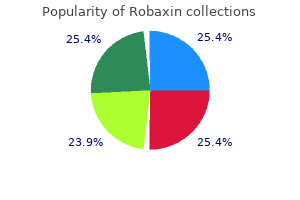Robaxin

"Cheap 500 mg robaxin visa, spasms on left side of abdomen".
A. Brant, M.B. B.CH., M.B.B.Ch., Ph.D.
Co-Director, University of Colorado School of Medicine
Pain Management Best Practices InterAgency Task Force Report: Updates spasms lower back pain robaxin 500 mg line, Gaps spasms right flank 500mg robaxin amex, Inconsistencies infantile spasms 4 year old quality robaxin 500 mg, and Recommendations muscle relaxant 4211 v buy cheap robaxin 500mg. Thilander, Prevalence of symptoms of functional disturbances of the masticatory system in Swedish men. Czarnecka, Results of epidemiological examinations of the temporomandibular joint in adolescents and young adults. Egermark-Eriksson, An evaluation of the need and demand for treatment of craniomandibular disorders in a young Swedish population. Newbrun, Comparison of trends in the prevalence of caries and restorations in young adult populations of several countries. Carlsson, Sick-leave in patients with functional disturbances of the masticatory system. Reinhardt, the behavioral management of chronic pain: long-term follow-up with comparison groups. Curriculum guidelines for the development of pre-doctoral and post-doctoral programs in temporomandibular disorders and orofacial pain. Analyses of anamnestic and clinical recordings of dysfunction with the aid of indices. Proceedings of the National Academy of Sciences of the United States of America, 1977. Fields, Endogenous pain control systems: brainstem spinal pathways and endorphin circuitry. Herdegen, Control of Gene Transcription by Jun and Fos Protiens in the Nervous System. Mense, Blockade of nitric oxide synthase differentially influences background activity and electrical excitability in rat dorsal horn neurones. Perl, Excitation of marginal and substantia gelatinosa neurons in the primate spinal cord: indications of their place in dorsal horn functional organization. Hawker, the prevalence of altered sensation associated with implant surgery (see comments). Pharmacological approaches to the treatment of chronic pain: new concepts and critical issues. Srinivasa, Is Nociceptor Activation by Alph-1 Andrenoreceptors the Culprit in Sympathetically Maintained Pain? Reeves, Quantification of changes in myofascial trigger point sensitivity with the pressure algometer following passive stretch. Craniomandibular disorders: guidelines for evaluation, diagnosis, and management. Lorenz, and (editors), New approaches to treatment of chronic pain: a review of multidisciplinary pain clinics and pain centers. McGrath, Narcotic analgesia: fentanyl reduces the intensity but not the unpleasantness of painful tooth pulp sensations. Graff-Radford, Reliability of the pressure algometer as a measure of myofascial trigger point sensitivity. Skootsky, Double Blind, Controlled Study of Different Myofascial Trigger Point Injection Techniques. Scapino, Remodeling of the temporomandibular joint disk and posterior attachment in disk displacement specimens in relation to glycosaminoglycan content. Gornbein, A multiple logistic regression analysis of the risk and relative odds of temporomandibular disorders as a function of common occlusal features. Seligman, the degree to which attrition characterizes differentiated patient groups of temporomandibular disorders. Harkins, Pain-related limitation in activities of daily living in patients with chronic orofacial pain: psychometric properties of a disability index. Carlsson, Recurrent headaches in relation to temporomandibular joint pain-dysfunction. Diagnosis and treatment of temporomandibular disorders: an ethical analysis of current practices. Treating temporomandibular disorders with permanent mandibular repositioning: is it medically necessary?
Diseases
- Fibrous dysplasia of bone
- Hydrolethalus syndrome
- Rosenberg Lohr syndrome
- Pili canulati
- Nystagmus, peripheral
- Ainhum
- Epiphyseal dysplasia dysmorphism camptodactyly
- Brunoni syndrome
- Epid
- Muscular fibrosis multifocal obstructed vessels

It is expected that at the end of the project about 25 spasms 1983 youtube discount robaxin 500 mg with amex,000 million tonnes of herbal medicines will be produced (Anonymous muscle relaxant pills over the counter cheap robaxin 500 mg with amex, 2003) spasms from coughing buy robaxin 500 mg amex. ProblemsandConstraints Bangladesh is an attractive repository of various medicinal plants spasms pain rib cage cheap 500mg robaxin free shipping. The scientific evaluation of the pharmacological properties of these plants would provide enormous potential and promise for developing newer, safer and more effective drug candidates. The information on proper identification, ecological niches and conservation measures of medicinal plants are yet to be included in scientific studies and documented. The conservation emphasis is limited mainly to rice and jute and information on genetic erosion 125 and extinction of plant species is also scanty. Meliaceae Meliaceae Asteraceae Apocynaceae Umbelliferae Verbenaceae Cucurbitaceae Apiaceae Euphorbiaceae Euphorbiaceae Rutaceae Moraceae Capparidaceae Labiatae Pandanaceae Rosaceae Combretaceae Combretaceae Combretaceae Tinospora cordifolia Willd (Hk. Part(s)used Flower, leaves, bark and roots Comments Large gardens in Habiganj, Jessore, Maniganj and Satkhira districts Cultivations in Habiganj, Jessore and Satkhira districts Large cultivations in Habiganj, Jessore and Satkhira districts Adhatoda vasica Nees. Triterpenes, saponins, flavonoids, tannins, alkaloids Essential oil, eugenol derivatives Flower, leaves, bark, oil and seeds Ocimum sanctum L. As expectorant, Leaves and seeds analgesic, for lowering blood pressure and blood sugar, in diarrhoea. As sedative, Roots remedy for high blood pressure, schizophrenia, in insomnia, epilepsy and other disorders of central nervous system Reduces blood pressure and cholesterol levels Bark, leaves and fruits in some cases Rauwolfia serpentina (Linn. Indole alkaloids including reserpine, rescinnamine, deserpine, yohimbine Cultivated in Habiganj, Jessore and Satkhira districts Terminalia arjuna (Roxb. Tannins, saponins, triterpenoids, sterols, flavonoids, alkaloids, glycosides Planted all over Bangladesh PhotographsofsomeleadingmedicinalandaromaticplantsofBangladesh Azadirachta indica A. The total land area of Bhutan is approximately 47,000 square kilometres with a population of 2,094,176. Bhutan is one of the poorest countries in the world where most of the population lives in rural areas and rely mainly on traditional medicines for their health care needs. Chronic diseases such as arthritis, rheumatism, liver and nervous disorders are generally treated with traditional medicines. The medicine system referred to as Sowa Rigpa owes its origin and development to ancient Tibet and is practised in many countries including Bhutan. It is based on the principles of Buddhism and uses about 300 of the 600 medicinal plants used in Bhutanese traditional medicines. Despite the wide availability of modern medicine, the local perception of illness is still deeply rooted in a strong Buddhist tradition. Different forms of traditional medical care are widely used and available in Bhutan (Dharmananda, 2002). GovernmentEffortsinDevelopmentofTraditionalMedicine the indigenous medicine system based on local plants and remedies is officially recognized by the government and provided free of charge along with modern medicine services. Two traditional dispensaries and the Institute of Traditional Medicine Services were founded in 1979 with the objective of establishing a traditional medicine system that is scientifically sound and technologically appropriate. The capital of Bhutan, Thimpu has a traditional medicine hospital (Dharmananda, 2002). The government plans to establish more such units to cover all 20 districts in the country. The officially recognized formal training of traditional medical doctors (drungtsho) began in 1971 in Bhutan with the establishment of a five-year drungtsho programme. The national policy on traditional medicine of the kingdom of Bhutan is currently being developed, as are laws, regulations and a national programme. MedicinalandAromaticPlantResources There are about 5,600 species of plants in Bhutan and 600 of them are medicinal. A wide range of plant diversity is found in two main mountain ranges, the Lho-Menjong and the Druk-Yul. These mountains provide over 300 plant species traditionally used in indigenous medicine. Some of Bhutanese medicinal and aromatic plants are given in Table 1 (Nawang, 1996). Bhutan also has a potential for producing various essential oils, namely calamus oil (Acorus calamus L. In 1988, a research unit was established within the Institute to conduct research for quality control of raw materials and finished products for traditional medicines as well as developing new products (Dharmananda, 2002).

Understanding these avenues has given us powerful physical spasms in chest generic robaxin 500 mg otc, psychological muscle relaxant drug test generic 500mg robaxin with amex, and pharmaco-therapeutic tools to stimulate or inhibit specific receptors thereby blocking pain or shutting down the signaling muscle relaxant tmj discount robaxin 500 mg free shipping. Modern understanding of receptors involved also permits us to understand certain side effects and select alternate drugs that activate different receptor pathways muscle relaxant allergy buy robaxin 500mg online. With appropriate training, pain therapy is no longer a hit or miss therapeutic exercise even though it is still an incomplete science. Instead, there is a large armamentarium of pharmacological, counter stimulation, behavioral, psychosocial, and rehabilitation therapies that work more directly on the pain mechanisms peripherally and centrally. During the past ten years, scientific advances have been made with a significant impact on the understanding and management of orofacial pain disorders. Neuropathic pain can be the consequence of any dental or surgical intervention in a few individuals in which peripheral nerves are affected, injured, sensitized, or altered during otherwise normal restorative, endodontic, non-surgical and surgical, periodontal, oral surgery, or implant procedures (70-71). A greater understanding of neuropathic pain mechanisms (nerve injury pain) has led to more accurate diagnosis and treatment of prior undiagnosed toothache and oral pains. Treatment of these conditions requires an understanding of peripheral and central sensitization and how to modify this with appropriate pharmacotherapeutics that have peripheral or central actions (51, 57, 58, 72). In addition, the role of the sympathetic nervous system in some neuropathic pain conditions that have not responded to treatment has become clearer (73, 74): more is now known about the adrenergic receptors involved in maintaining chronic pain states and what adrenergic agonist or antagonist medications are useful in altering sympathetic activity to stop this pain (75). Insight into the mechanisms of orofacial neurogenic inflammation has led to a more accurate diagnosis for tooth site pain that is non-odontogenic and non-neuropathic in nature (52, 54). Unfortunately, "toothache" from neurogenic dysregulation of the serotonin system often results in unnecessary tooth oriented procedures and finally extraction: and still the pain remains. The tooth site pain is partially the result of serotonin receptor activation of c-fiber depolarization (54). The treatment for this pain condition requires an understanding and use of medications used to treat neurovascular pain ("migraine"). Abortive migraine medications such as sumatriptan and dihydroergotamine give instant relief of this "toothache", and prophylactic medications such as beta blockers and calcium channel blockers are used to treat this condition over a longer time period. Specialty knowledge and training is required to treat these conditions currently because of lack of understanding of these types of conditions in the general dental and medical community. Acute pain is temporary and often self-limiting, has a specific observable cause and purpose, and generally has no persistent psychological reactions. Chronic pain, in contradistinction, is not self-limiting, appears permanent, often has no apparent cause, serves no discernible biological purpose, and can create multiple psychological problems that can confound the patient and clinician and perpetuate the problem. A patient with chronic pain may feel helpless and hopeless in his or her inability to receive relief. Although some patients learn to live with pain, others become anxious or depressed with high tension levels, sleep and appetite disturbances. They may focus much of their energy on analyzing the pain problem and see multiple health professionals searching for an organic cure. Near the end of this progression, some patients with chronic pain can have multiple drug dependencies, analgesic rebound headache from a steady diet of over the counter and prescription analgesics, transformed migraine headache, high stress levels, operant behaviors including chronic pain behavior, manipulation of medical, dental and social systems, conflicts in relationships, disrupted lifestyles, impaired ability to perform vocational, social or recreational functions, or perhaps become involved in litigation. These patients often do not receive relief from existing specialty dental delivery systems and usually require a multidisciplinary or interdisciplinary approach involving an Orofacial Pain practitioners. Chronic pain syndromes have been recognized in fields such as headache and low back pain, and apply equally to orofacial pain. Studies of patients with chronic orofacial pain have found lifestyle problems similar to that of other chronic pain syndromes (22, 24). For example, a 1986 Harris Poll (9) found that head pain causes more missed work days among employed workers than any other type of pain. In addition, research involving oral stress habits, stress-tension behavior, and depression suggests that each plays some role in orofacial pain disorders (26, 27, 77, 78). Issues such as pain behavior, secondary gain and operant learning have been identified as significant contributing factors that need intervention to achieve pain management (23, 29). These theories have provided significant impetus to developing interdisciplinary teams. Unfortunately, when organic sources of painful stimulus are absent or equivocal, medical or dental practitioners may be drawn into treatment of more understandable or more discernable findings such as malocclusion or temporomandibular joint noises rather than opening up to psycho-social and behavioral issues that may be driving chronic pain. Chronic pain, sleep disturbance, depression, chronic myofascial pain, fibromyalgia, and migraines all share some commonalities in neurochemistry as well as often combine as multi-factoral problems in chronic pain patients. This reinforces the need for integrated therapy rather than compartmentalizing the patient. Chronic pain rehabilitation programs have been applied to orofacial pain with success similar to clinics for other types of pain (80).

The pledge driver just wanted to make sure they could fill in the blanks with somebody reasonable for the upcoming ninety-day probation quetiapine spasms robaxin 500mg generic. When they got home after signing the contract spasms of the larynx order 500 mg robaxin otc, Mahoney had a message on his answering machine from Delorenzo spasms 1983 generic robaxin 500mg mastercard, and called him back that night since both were emergency medicine residents together at the Hershey Medical School spasms after bowel movement generic 500 mg robaxin. He never palled around with Joe, but found him a straightforward guy, although somewhat boring, always talking about medicine, emergency medicine. Like most newly-graduated residents, Delorenzo was a purist who viewed emergency medicine with rose-colored glasses. After his residency, he set up an optimal system of hospital contracts, holding contracts with three major hospitals outside of Cincinnati, and had twenty-two physician members of the group rotating shifts based on a computer program devised by Delorenzo. The income of the group was evenly divided based upon the number of shifts each physician worked, with incentive payments for doing nights and weekends. Delorenzo took fifty-six thousand dollars a year for managing the three-hospital group, a paltry sum by the "suits" standards, not enough gold to even fill a tooth. The "suits" would have easily soaked the three hospitals for a minimum of six hundred thousand, and most likely a lot more, a mere five hundred and forty-four thousand dollars more than Delorenzo took. His group became a progressive model for the nation, a model literally shunned by many members of the board of directors and the corporate officers of the American Academy of Emergency Physicians. Delorenzo himself was exceptionally competent and very well liked and respected, having been elected chief of the entire medical staff at one of the hospitals. Doctor Delorenzo was "quality assured" not only by the public, but by the inside track of the medical staff who had a different set of standards than the public. One of the first things Delorenzo did was eliminate a number of various activities taking place in many emergency rooms throughout the country, namely, other specialists performing procedures or doing risky treatments in the emergency room. There were many rea- the Rape of Emergency Medicine Page 146 sons for Delorenzo to do this. Gastroenterologists have to sedate patients before placing the flashlights up their colons, and it was no secret, the more they "snowed" the patient, the further they were able to thread their light up that lucrative highway. The hematologist-oncologists (hem-onc) gave blood-component transfusions in the emergency room, tying up a bed or two every morning. The hem-onc crowd was a pretty responsible group, but the transfusions were risky, involving chronically-ill patients who were time bombs if the smallest thing went sour. Everyone knows the first rule of medicine while in the emergency room is never to carry the casket yourself. But Delorenzo put a stop to it in all three hospitals, pointing out the emergency physician was relieved of all legal responsibility for these patients if a true emergency hit the emergency department. Delorenzo told the O-J-T-ers this was 1992 and everybody, including twelve-membered juries, were more sophisticated, making the O-J-T-ers squirm, readily aware he was right. Delorenzo pointed out the nephrologists never set up dialysis in the emergency room. They had their own center, and, even in emergencies, had their own dialysis room within the hospital, never dialyzing a patient in the emergency department. Delorenzo explained, "Ambulatory-care centers and day-surgery facilities are the optimal locations for these activities, and if the hospital would buy into them, it would make economic sense, remove liability from the hospital, and actually represent a progressive step for everyone. One three-year old once fell to the floor after getting off the stretcher, the weight of the cast following the law of gravity, clunking the tot to the ground when she tried to stand up. Monk was let go by Delorenzo after two shifts, and after the Monk episode, Delorenzo drew up guidelines that all new emergency physicians were to be proctored by an experienced member of the group before any final decisions on hiring were made. The other fifteen orthopods were very responsible, always coming in for open fractures and sever orthopedic conditions. As the chief of staff, Delorenzo threw some weight around, clearing up a problem no one else wanted to deal with, and things progressed in the right direction with only a few ruffled feathers. The O-J-T-er noted Cincinnati had a good football team, and he also liked golf, Beluga, and Dom Perignon. What was Bing doing here all the way from Boston in one of the hospitals in Cincinnati? Next he saw Lyle, Valerie Longo, the chartsy-graphsy couple, the administrator, the recently-hired assistant administrator, and then the gastroenterologist followed by the "chronic" orthopedist.
